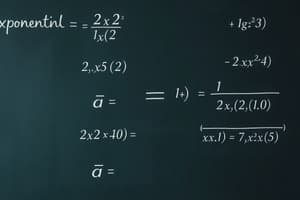Podcast
Questions and Answers
What is the parent equation for exponential functions with a base of 2?
What is the parent equation for exponential functions with a base of 2?
y = 2^x
What is the parent equation for logarithmic functions with a base of 2?
What is the parent equation for logarithmic functions with a base of 2?
x = 2^y
What is the log notation for representing the inverse of the exponential y = b^x?
What is the log notation for representing the inverse of the exponential y = b^x?
y = log_b x
The logarithmic form x = b^y is considered explicit because it directly represents y as a function of x.
The logarithmic form x = b^y is considered explicit because it directly represents y as a function of x.
What restrictions are there on the value of x in log_b x?
What restrictions are there on the value of x in log_b x?
In the logarithmic notation y = log_b x, the variable ______ represents the base.
In the logarithmic notation y = log_b x, the variable ______ represents the base.
In the logarithmic notation y=log_b x, the variable ______ represents the answer, which is the result of raising the base to the exponent.
In the logarithmic notation y=log_b x, the variable ______ represents the answer, which is the result of raising the base to the exponent.
In the logarithmic equation y=log_b x, the variable ______ represents the exponent to which the base should be raised.
In the logarithmic equation y=log_b x, the variable ______ represents the exponent to which the base should be raised.
How do you evaluate a logarithm?
How do you evaluate a logarithm?
What is the exponential form of the logarithmic equation log_5 25 = 2?
What is the exponential form of the logarithmic equation log_5 25 = 2?
What is the logarithmic form of the exponential equation 3^5 = 243?
What is the logarithmic form of the exponential equation 3^5 = 243?
What is the logarithmic form of the exponential equation 4^(-3) = 1/64?
What is the logarithmic form of the exponential equation 4^(-3) = 1/64?
What is the general formula for evaluating a logarithm?
What is the general formula for evaluating a logarithm?
What is the value of log_1 x, for any positive value of x?
What is the value of log_1 x, for any positive value of x?
What is the value of log_b b, where b is a positive base?
What is the value of log_b b, where b is a positive base?
In general terms, what is the value of log_b(x^n)?
In general terms, what is the value of log_b(x^n)?
Flashcards
Exponential function
Exponential function
A function where the variable is the exponent.Example: y = 2^x
Inverse of exponential
Inverse of exponential
A function that undoes the operation of the exponential function.
Logarithm
Logarithm
The inverse of an exponential function.
Logarithmic notation
Logarithmic notation
Signup and view all the flashcards
log_b(x)
log_b(x)
Signup and view all the flashcards
log_b(1)
log_b(1)
Signup and view all the flashcards
log_b(b)
log_b(b)
Signup and view all the flashcards
log_b(b^x)
log_b(b^x)
Signup and view all the flashcards
b^(log_b(x))
b^(log_b(x))
Signup and view all the flashcards
Exponential form
Exponential form
Signup and view all the flashcards
Logarithmic form
Logarithmic form
Signup and view all the flashcards
Study Notes
Exponential and Logarithmic Functions
- Exponential functions have a variable in the exponent, like y = 2x.
- Logarithmic functions are the inverse of exponential functions.
- Logarithmic notation: y = logbx where:
- y is the exponent
- b is the base
- x is the answer when b is raised to the power of y.
- Exponential form to logarithmic form: by = x is equivalent to logbx = y
- Converting to exponential form allows solving equations.
Characteristics of Exponential Functions (base 2)
- Parent equation: y = 2x
- Sketch: Typical exponential graph shape, increasing from left to right.
- Domain: All real numbers
- Range: Y > 0
- Y-intercept: (0, 1)
- X-intercept: None (the graph never crosses the x-axis)
- Asymptotes?: y = 0 (horizontal asymptote)
- Interval of Increase: All real numbers
- Interval of Decrease: None
Characteristics of Logarithmic Functions (base 2)
- Parent equation: x = 2y (or equivalent logarithmic form)
- Sketch: Typical logarithmic graph shape, increasing from left to right. Mirror image of the exponential graph across the line y = x.
- Domain: X > 0
- Range: All real numbers
- Y-intercept: None
- X-intercept: (1, 0)
- Asymptotes? x = 0 (vertical asymptote)
- Interval of Increase: All real numbers
- Interval of Decrease: None
Evaluating Logarithms
- To evaluate a logarithm, convert it to exponential form and solve.
- Examples include evaluating log525, which corresponds to 5y = 25 to solve for y.
Studying That Suits You
Use AI to generate personalized quizzes and flashcards to suit your learning preferences.




